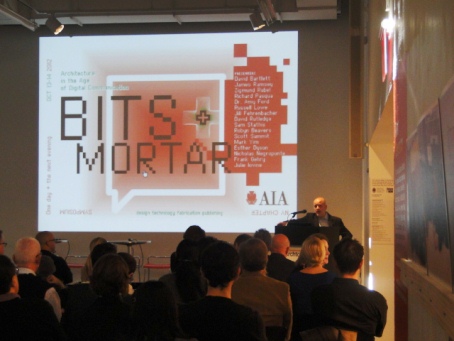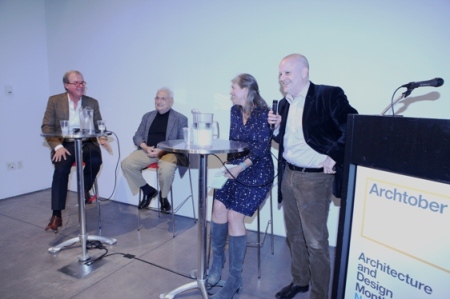by: Julie Trebault
Event: Bits + Mortar: Architecture in the Age of Digital Communication Symposium
Location: Center for Architecture, New York, 10.13.12 and 10.14.12
Speakers: Paul Seletsky, AIA, AIANY Technology Committee Co-Chair; Nicholas Negroponte, Founder, MIT Media Lab, OLPC; Esther Dyson, angel investor, entrepreneur, philanthropist, and commentator; Julie Iovine, Journalist; and Frank Gehry, FAIA, Principal, Gehry Partners; click here and here to have a look at the full list of speakers.
Organizers: AIANY Technology Committee
Sponsors: 1100: Architecture; 3dsystems; ABC Imaging and Theometrics
Supporters: Array Health Systems; Bentley Systems; Point B Design; Robert Silman Associates; VIP Networks
Media Sponsor: The Architect’s Newspaper
Architects, designers, inventors, and thinkers gathered in Tafel Hall on a weekend this Archtober. The symposium, as described by architect, digital design guru, and AIANY Technology Committee Co-chair Paul Seletsky, AIA, was to foster a critical discussion and create awareness of the relationship between science and art in the design process. For instance, how can a collaborative approach benefit architectural practice?
It was a stimulating dialogue between the Mortar (architects) and the Bits (inventors of new technologies), who shared many revolutionary ideas with the audience. Among the topics discussed was how to filter natural light into the underground Lowline – a park proposed for the abandoned Williamsburg Bridge Trolley Terminal – to let trees grow. On the table now is a brilliant system called “remote skylights.” Another interesting invention was “the slingshot,” a vapor distillation system that cleans contaminated water. This device could become a key instrument in providing clean water to the 900 million people worldwide who do not have a easy access to drinking water. The discussion shed light on how sustainability, clean energy, water, and ergonomic design provide positive social value and can effectively change people’s lives.
Smart use of new technologies can also allow architects to be more innovative and provocative, which enhances collaboration. As Nicholas Negroponte, founder of MIT’s Media Lab and creator of the One Laptop per Child project, pointed out in his keynote session, “Without digital technology, Frank Gehry’s projects could not have been built!” Open-source architecture is one of many other opportunities to efficiently develop the practice of architecture.
Digital technologies have changed the world, and have brought art and architecture along for the ride. In his final keynote, Frank Gehry, FAIA, suggested that adding a zest of fantasy in this mechanical world and taking more responsibilities as an architect can keep the dreaming process intact. Perhaps computer information is just the tool to expand collaboration to enable the generation of new ideas.
Julie Trebault is AIANY’s communications coordinator.










